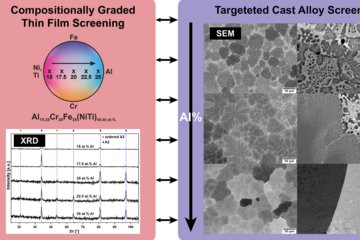All genres
561.
Journal Article
Shear-induced mixing governs codeformation of crystalline-amorphous nanolaminates (Erratum: Physical Review Letters (2014) 113 (035501)). Physical Review Letters 113 (6), 069903 (2014)
562.
Journal Article
Atom probe tomography observation of hydrogen in high-Mn steel and silver charged via an electrolytic route. International Journal of Hydrogen Energy 39 (23), pp. 12221 - 12229 (2014)
563.
Journal Article
Grain boundary segregation engineering in metallic alloys: A pathway to the design of interfaces. Current Opinion in Solid State and Materials Science 18 (4), pp. 253 - 261 (2014)
564.
Journal Article
Superplastic Mn–Si–Cr–C duplex and triplex steels: Interaction of microstructure and void formation. Materials Science and Engineering A: Structural Materials Properties Microstructure and Processing 610, pp. 355 - 369 (2014)
565.
Journal Article
Multiple reentrant glass transitions in confined hard-sphere glasses. Nature Communications 5, 4435 (2014)
566.
Journal Article
Shear-induced mixing governs codeformation of crystalline-amorphous nanolaminates. Physical Review Letters 113 (3), 035501 (2014)
567.
Journal Article
High strength and ductile low density austenitic FeMnAlC steels: Simplex and alloys strengthened by nanoscale ordered carbides. Materials Science and Technology 30 (9), pp. 1099 - 1104 (2014)
568.
Journal Article
A novel approach to measure grain boundary segregation in bulk polycrystalline materials in dependence of the boundaries’ five rotational degrees of freedom. Scripta Materialia 81, pp. 16 - 19 (2014)
569.
Journal Article
Crystallization, phase evolution and corrosion of Fe-based metallic glasses: an atomic-scale structural and chemical characterization study. Acta Materialia 71, pp. 20 - 30 (2014)
570.
Journal Article
Dislocation density distribution around an indent in single-crystalline nickel: Comparing nonlocal crystal plasticity finite-element predictions with experiments. Acta Materialia 71, pp. 333 - 348 (2014)
571.
Journal Article
Hydrogen-assisted decohesion and localized plasticity in dual-phase steel. Acta Materialia 70, pp. 174 - 187 (2014)
572.
Journal Article
Ductility improvement of Mg alloys by solid solution: Ab initio modeling, synthesis and mechanical properties. Acta Materialia 70, pp. 92 - 104 (2014)
573.
Journal Article
Influence of the dislocation core on the glide of the ½<111>{110} edge dislocation in bcc-iron: An embedded atom method study. Computational Materials Science 87, pp. 274 - 282 (2014)
574.
Journal Article
Long-term microstructural stability of oxide-dispersion strengthened Eurofer steel annealed at 800°C. Journal of Nuclear Materials 448 (1-3), pp. 33 - 42 (2014)
575.
Journal Article
The influence of manganese content on the stacking fault and austenite/epsilon-martensite interfacial energies in Fe–Mn–(Al–Si) steels investigated by experiment and theory. Acta Materialia 68, pp. 238 - 253 (2014)
576.
Journal Article
Atom probe tomography study of ultrahigh nanocrystallization rates in FeSiNbBCu soft magnetic amorphous alloys on rapid annealing. Acta Materialia 68, pp. 295 - 309 (2014)
577.
Journal Article
Correlations of plasticity in sheared glasses. Physical Review E 89 (4), 040301 (2014)
578.
Journal Article
Effect of retained beta layer on slip transmission in Ti–6Al–2Zr–1Mo–1V near alpha titanium alloy during tensile deformation at room temperature. Materials and Design 56, pp. 937 - 942 (2014)
579.
Journal Article
Modelling of dendritic growth during alloy solidification under natural convection. Modelling and Simulation in Materials Science and Engineering 22 (3), 034006 (2014)
580.
Journal Article
Atomic-scale quantification of grain boundary segregation in nanocrystalline material. Physical Review Letters 112, 126103 (2014)











